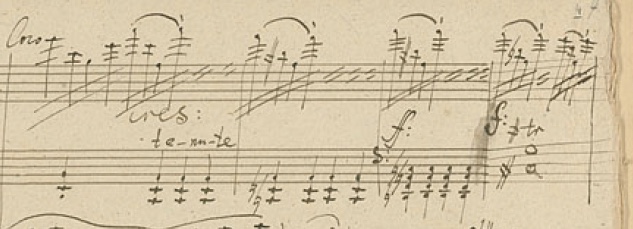Page 3 of 3
Re: double-stopped trills
Posted: 11 Aug 2021, 10:19
by OCTO
John Ruggero wrote: ↑11 Aug 2021, 02:34
And as I mentioned, there is also the possibility of placing the accidental to the
left of the tr symbol. That was Beethoven's system, and it has the advantage of not conflicting with a trill line.
Interesing.
Once I placed the accidental below the trill symbol, in a very similar situation as in the OP, but I am not sure that that was the right way.
Re: double-stopped trills
Posted: 11 Aug 2021, 16:22
by John Ruggero
Placing the accidental below the tr might be cause some players to think the trill is to the lower rather than upper auxiliary tone since that is where it is placed for the lower auxiliary for turns.
Here is an example of Beethoven's trill accidental from the Piano Sonata op. 78:

- Beethoven trill.jpeg (80.46 KiB) Viewed 9283 times
Re: double-stopped trills
Posted: 11 Aug 2021, 17:11
by MichelRE
I'm not even sure why that sharp is there. considering the context and key, isn't it obvious that the "trill to" note is an E#?
my Kalmus edition leaves out the superfluous accidental on that trill. (it also standardizes Beethoven's oddly sloppy use of enharmonics).
Re: double-stopped trills
Posted: 11 Aug 2021, 19:28
by David Ward
Interesting: my Peters edition also has F double sharp instead of G natural. However, John is in the process of preparing a new edition of the Beethoven sonatas (to which I'm greatly looking forward) based on extensive research and careful analysis, so I expect he may have a very well considered explanation of why Beethoven chose to notate it this way.
Re: double-stopped trills
Posted: 12 Aug 2021, 02:35
by John Ruggero
It's a cautionary accidental because of the E natural in the previous measure. All of the editions that I have, Schenker, Schnabel, Arrau, von Buelow, Craxton-Tovey, Casella, old Peters etc. include it and some position it before the trill as was Beethoven's practice.
Most editions correct the enharmonics (Scbenker), but Schnabel doesn't. I'll keep it as in the manuscript and first edition in my edition because it's typical of Beethoven trying to keep the chordal notation user-friendly for the players who might be uncomfortable in a key that was not so common at that time.
The trill and the enharmonics are all notated exactly the same way in the recapitulation transposed to the tonic key, so it is definitely intentional and not a slip of the pen.
Here is another one from the first edition of op. 106:

- op 106 trill.jpeg (61.67 KiB) Viewed 9266 times
Re: double-stopped trills
Posted: 12 Aug 2021, 09:46
by David Ward
Curious, my (newer) Peters edition has the sharp before the trill to A sharp in the recapitulation, but not in the exposition when it trills to E sharp. This seems inconsistent. There's a B sharp in the left hand, mirroring the F double-sharp from the exposition. I presume, though, that the manuscript has C natural here.
John will know a lot more about this than me, but I believe that the Op 78 sonata may have been a genuine gift for Therese von Brunswick of whom Beethoven was genuinely fond. He chose an extreme key, but might not have wanted to make the notation more difficult than he felt necessary.
Re: double-stopped trills
Posted: 12 Aug 2021, 15:38
by John Ruggero
David Ward wrote: ↑12 Aug 2021, 09:46
Curious, my (newer) Peters edition has the sharp before the trill to A sharp in the recapitulation, but not in the exposition when it trills to E sharp. This seems inconsistent. There's a B sharp in the left hand, mirroring the F double-sharp from the exposition. I presume, though, that the manuscript has C natural here.
My Peters edition (1978) edited by Arrau has the sharp for both trills. Here is the same spot in the recap:

- op 78 example 2.jpeg (59.31 KiB) Viewed 9232 times
"...the Op 78 sonata may have been a genuine gift for Therese von Brunswick of whom Beethoven was genuinely fond. He chose an extreme key, but might not have wanted to make the notation more difficult than he felt necessary." (David Ward)
That is certainly a plausible theory. The sonata was in fact dedicated to Therese von Brunswick and may have been intended, along with op. 79, to be an "easier" sonata, in contrast the immediately previous op. 53, 54 and 57. While not easy, the second movement in particular certainly sounds much harder than it actually is to play.